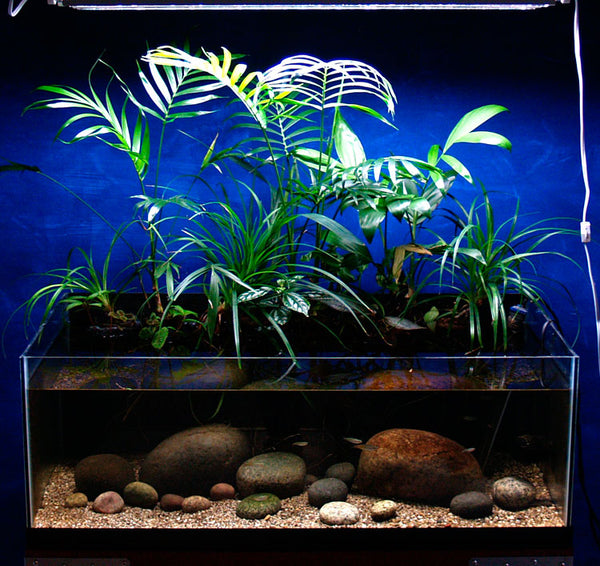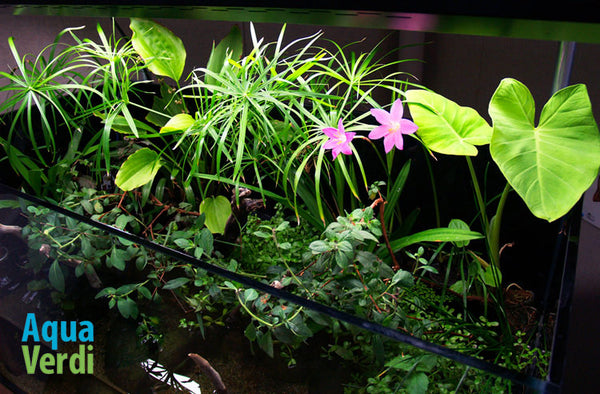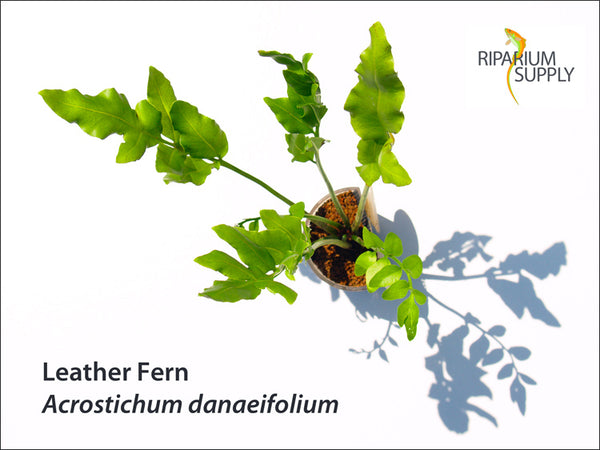News / CO2
Swamp Tank: Happy Plants in the Riparium Setup at Fish Planet in Deerfield, Illinois
Steve at Fish Planet sent us a few update shots for his showroom riparium planting. The plants look very good and the tank has been a big hit with customers. The following lists basic specifications for this planted model ecosystem:
- Tank - 45-gallon cube (24" X 24") - a great size and shape for a riparium planting
- Lighting - 4X 24", 6,500K HO T5 lamps in pendant fixture, lighting for underwater area supplemented with Finnex I LED strip
- Water circulation/filtration - Eheim 2213 canister supplemented with 100 gph power filter
The robust plant growth above and below water provides lots of natural water purification and habitat structure, allowing for an active fish display with lots of animals. Livestock include Neon Dwarf Rainbows, Silver Hatchetfish, Pygmy Cories and Burmese Rasboras. Among the submerged aquatic plants are various Crypts, Java Fern and Christmas Moss. Riparium plants include Colocasia Dwarf Taro, Ruellia Dwarf Bluebell, Ruellia Tall Bluebell and Acorus Japanese Sweetflag. Notice also the floating leaves of Nymphaea Dwarf Lily.

There is no CO2 injection to enhance underwater plant growth; the tank uses instead a natural approach with the generous fish stocking and bioactive substrates. The riparium plants of course acquire all of the carbon dioxide they need directly from the air, where it is usually much more available than underwater. The submerged plants and riparium plants do benefit with twice-weekly fert dosing for NPK and micronutrients.
We look forward to more updates on this beautiful riparium. It looks as the the Ruellia plant might flower soon with its lovely pink blossoms. That will be a treat!
Neon Dwarf Rainbowfish (Melanotaenia praecox) - an excellent choice for an active fish display in a planted tank.

Colocasia Dwarf Taro with other riparium foliage

The Ruellia Tall Bluebell has numerous flower buds and will bloom soon.

Video: Planting the Limpet Moss Mount
Our newest video details planting of the Limpet Moss Mount with some new tissue culture plants. Follow this link to watch on YouTube...
Video: Planting the Limpet Moss Mount
The Limpet is a laser-cut acrylic plate supplied with a heavy-duty suction cup and it works well with plants that grow on hard substrates, such as Aunties, smaller Java fern, Bucephalandra and aquarium mosses. In contrast with moss ledges of comparable design, the Limpet Moss Mount plate hangs vertically, so it can look more natural in the aquarium and it will cast less shade on other plants as the mosses grow in.

Use the Limpet Moss Mount to expand your aquarium growing area and propagate plants for trades or aquascapes. With moss or other plant grown to cover the mount, the Limpet can also function as a unique aquascape feature. It will additionally create new habitat for aquarium livestock and it might even function well as a spawning mop for killifish and other egg scattering fish.

The Limpet Moss Mount is packaged as a 2-pack. Make sure to review the instructions on the reverse side of the packaging as you get ready to plant. As with our other glass-mount accessories, the heavy-duty suction cups will provide a strong grip for a long time if the aquarium glass is carefully cleaned with a razor blade or similar scraper before positioning.
Have fun with with your aquarium plantings!
No extra CO2 Required!...And Other Reasons for a Planted Riparium as Your Next Aquascape.
We are quickly approaching the long, grey, cold winter months and the best time of year for new aquascaping projects. As you start planning your new layouts, consider trying a planted riparium.

Above, riparium layout in a 40-gallon tank.
Ripariums are a special kind of planted tank featuring marginal aquatic plants; species adapted to grow their roots in very wet soil or in the mud under shallow water, but with most of their foliage in the air. Some very popular aquarium selections, such as Cryptocoryne, Echinodorus, Anubias and many stem plants can grow as marginals with emersed-adapted foliage growing above water, although for aquariums these are usually grown in their immersed (underwater) forms.
Ripariums are further distinguished from another special kind of planted model ecosystem, the paludarium. While they look superficially similar, paludariums use a built-up hardscape to support the planting, whereas ripariums use planter cups positioned on the aquarium glass. Furthermore, the paludarium hardscape is intended to function as part of the visual design, while the riparium planters are hidden from view as the plants grow in.
The following lists the most appealing features of planted ripariums as living displays:
- No extra CO2 required - carbon dioxide gas, essential for plant growth, is many times more available in the air than underwater. Plants in traditional aquascapes are usually limited more be the availability of CO2 than any other factor, so serious aquascapers install CO2 injection systems with pressurized tanks, regulators and diffusers. While CO2 systems can be fun to set up and run, they also represent extra expense and maintenance demands. Riparium plants easily get all of the carbon dioxide they need from the air, so they do not need extra CO2 for vigorous growth.
- Biotope representation - some of the most beautiful wild aquatic ecosystems have few fully submerged underwater plants. Among these are blackwater swamps, mangrove swamps, mountain streams and others with underwater conditions that are tough for plants. These habitats are home to many of the most appealing aquarium fishes, while also hosting distinctive marginal aquatic plant species. A planted riparium is the best way to represent this kind of area with an aquascape biotope.
- Robust plant-based filtration - riparium plants, not limited by availability of dissolved CO2 or algae growth, can grow quickly with new foliage and roots. As they accumulate biomass, the riparium plants will also remove fish waste products (especially phosphate and nitrates) and other pollutants.
- Beautiful blooms and foliage - having evolved in the special marginal aquatic habitat, the best choices for planted ripariums have distinctive shapes, colors and growth habits. If provided with the right nutrition and lighting, a number of the best riparium selections, such as Ruellia, Spathiphyllum, Hymenocallis and Zephyranthes, will also bloom readily with lovely flowers. The planted riparium genre is relatively new in the aquarium hobby and there are still many new plants to be discovered and trialed as riparium choices.
Thank you for reading! We hope that you can also enjoy creative challenges and new discoveries with planning and building a new riparium aquascape.

Above, 120-gallon Mexico river riparium biotope.

Above, Planting Zephyranthes Rain Lily in Aqua Verdi Riparium Planter.

Above, the lovely white bloom of Zephyranthes Rain Lily in a planted riparium.

Above, a Borneo blackwater swamp riparium biotope.

Above, Acrostichum Leather Fern in a riparium planter.



